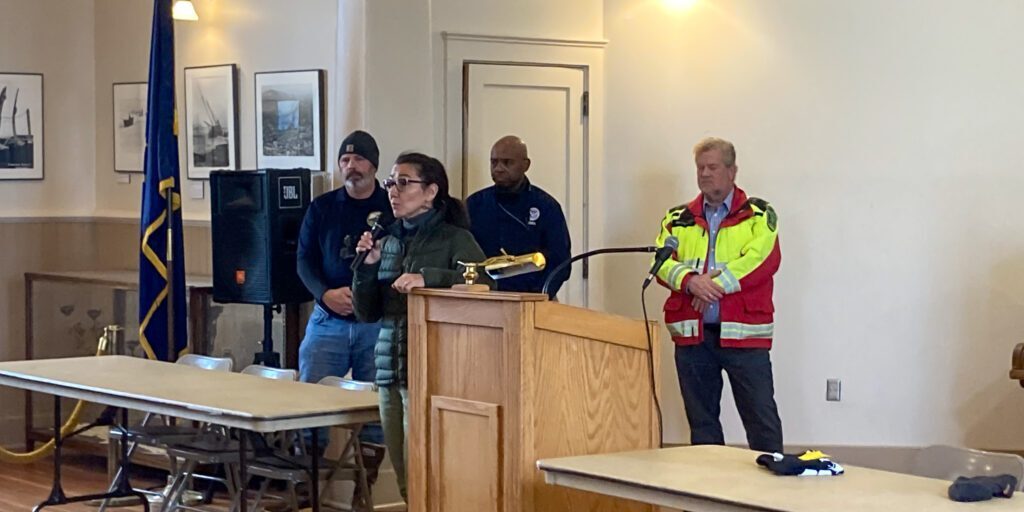Now that President Joe Biden has declared a major federal disaster for Western Alaska after last weekend’s storm, government officials are assessing the damage and their priorities for recovery.
KNOM spoke with Representative Mary Peltola, Senator Lisa Murkowski and FEMA Administrator Deanne Criswell in Nome.
To cap off her visit to Western Alaska, FEMA Administrator Criswell was able to meet with Nome residents on Saturday, Sept. 24, and hear directly from them about storm damage and their needs.
She told KNOM that FEMA will support debris removal and emergency repairs over the next three to five weeks before winter hits the region.
“It really was eye opening to really realize that as we were flying over these communities, and being able to truly see one; how exposed they are to the elements and the storm that came in, and then two; the extreme difficulty that it’s going to bring to try to provide the needed support that’s going to have to happen quickly over the next few weeks but then in the long term,” Criswell explained.
Representative Mary Peltola said she was very happy to be in the Nome area and to meet with locals directly. Although her time in the Bering Strait region was brief, Peltola knows from experience that rebuilding subsistence camps, replacing gear and shipping up materials will be challenging.
“I’ve been trying to get an outboard motor for two years,” Peltola said. “Even with the reimbursements, it’s going to be very hard for families to find the ATVs and snowmachines, and outboard motors and skiffs they need. These are all in high demand and we’ve got logistic issues. So it’s really incumbent upon all of us to do what we can on our end to make it as painless on residents as we can.”
During the federal officials’ visit to Nome, FEMA opened up its disaster assistance portal to Alaskans affected by the recent storm. Funding is now available to local, state and tribal governments in the damaged areas of Western Alaska.
The Alaska Department of Homeland Security and Emergency Management’s online assistance application, which mirrors FEMA’s, opened Monday morning, DHSEM Director Bryan Fisher said.
The state’s number one priority is getting Western Alaskans back into safe, secure and warm homes, Fisher said.
“Our priority with respect with to the individuals and families that live out there is to remove the contaminated insulation, and replace bellyboard, replace tin that might have been lost on folks’ roofs, replace Toyo stoves if they were damaged and flooded, upright fuel tanks. Our program does allow to provide financial aid to refuel those fuel tanks, home heating tanks, if they were lost or spilled in the disaster,” Fisher said.
Senator Lisa Murkowski was on the ground in Golovin and Elim last week where she saw asphalt roads peeled back, houses moved hundreds of feet and all kinds of storm impacts like significantly exposed permafrost.
She wants to remove the cost-share stipulation from the federal disaster funding issued by the President.
“I think our push needs to be to ask for additional relief by way of assistance with cost-share waiver. I noted that the President had provided for 100% of cost reimbursement for 30 days to help with debris removal,” said Murkowski.
Beyond those 30 days, FEMA is prioritizing a plan to provide assistance to individuals and to rebuild infrastructure in Western Alaska for the long term, FEMA Administrator Criswell said. But she also wants to be better prepared for future storms.
State Department of Transportation officials continue to make progress on fixing sections of road east of Nome, but other infrastructure projects like repairing the Safety Sound bridge will most likely have to wait until next summer.
The state now has hundreds of National Guardsmen and women, staff from DHSEM, and other responders from the Red Cross on the ground in Western Alaska providing recovery assistance as needed, according to Fisher.
Image at top: Mary Peltola speaks at the Sept. 24 town hall meeting. Photo by John Coe, KNOM (2022).




